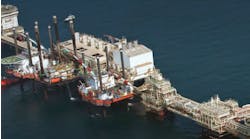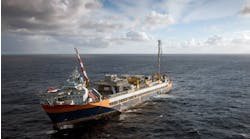HOUSTON, May 1 -- The East Coast of Canada will be a growing exporter of oil, natural gas, and electric power to US markets within the next few years, the premiers of Nova Scotia and of Newfoundland and Labrador provinces said Tuesday at the Offshore Technology Conference in Houston.
"Nova Scotia will be a player in the North American energy strategy by producing approximately 1 bcfd of gas by the middle of this decade and possibly double that by the end of the decade," said Nova Scotia Premier John Hamm at a press conference.
"Technology is edging to the point where we could send electricity as well as gas to northeast markets," he said. "In the long run, new industries will locate closer to our environmentally friendly, reliable energy source."
The Grand Banks and Nova Scotia offshore areas have an estimated 5.3 billion bbl of conventional oil reserves and 63 tcf of gas reserves, Canadian officials reported.
"Offshore Atlantic Canada offers tremendous potential for new oil and gas discoveries and a wide variety of investment opportunities," said Roger Grimes, premier of the Newfoundland and Labrador province.
The 127 exploration wells drilled off Newfoundland and Labrador so far have produced 23 significant discoveries. Of those, 18 are located on the northern Grand Banks, with five off Labrador.
"The northern Grand Banks discoveries contain over 2 billion bbl of recoverable oil, 5 tcf of natural gas, and almost 300 million bbl of natural gas liquids. Discoveries offshore Labrador contain an additional 4 tcf of recoverable natural gas and over 100 million bbl of natural gas liquids," Grimes said.
Assessments of that offshore area indicate more than 6 billion bbl of oil still to be discovered and more than 50 tcf of recoverable gas, he said.
About 7 tcf of gas has been found off Nova Scotia. "But with more than $1 billion in exploration now set for the next 4 1/2 years, that number is sure to grow," Hamm said.
Estimates of Nova Scotia's offshore potential range from 40 tcf to 100 tcf. Looking at the whole of Canada's east coast, Hamm said, "It doesn't take much to get to an outside number of 160 tcf."
Moreover, he said, "We have a very important edge over other (Alaskan and Canadian) frontiers -- proximity to markets, something the northern developers would dearly love to have."
The Maritimes Northeast Pipeline infrastructure is already in place, with New England and eastern Canadian markets only some hundreds of miles away.
"Plans to add compression and looping for this pipe to accommodate recent and future discoveries are already being drawn up," said Hamm. "And several major industry players are starting to examine the feasibility of a subsea route from the offshore to Nova Scotia to New England and New York. They are working on pipeline models that are at least as large as the Maritimes Northeast line to carry gas that has yet to be discovered."
Grimes said, "There are a number of transportation options available which can move our offshore gas resources to US markets, including transportation by ships containing compressed natural gas or LNG and, of course, via pipeline. Each of these options is commercially viable under the right market conditions."
Studies demonstrate "that our discovered gas resource base in the Grand Banks can support plateau gas production of about 700 MMcfd for about 15 years," he said. "I believe that by governments, industry, and businesses working together, we can get our offshore gas to market by or before 2010 via the pipeline option."
One of the most promising areas off Canada's east coast is the Laurentian subbasin, scene of a longstanding boundary dispute between the two provinces. That dispute was submitted to an arbitration tribunal in March and could be resolved this month, the two premiers said.
During the press conference, Grimes announced nearly 5 million acres in 14 separate parcels off Newfoundland are being offered for bids through Nov. 20.
Parcels 1-3 are located in the Flemish Pass basin where "over the last couple of years we have seen exceptionally high bids for parcels ... by Petro-Canada and Norsk Hydro [AS]," said Grimes. "Indeed, Petro-Canada has indicated that it has identified five targets on their acreage that could contain giant fields, each with a possible recoverable oil resource of about 500 million bbl. These companies are expected to begin drilling in this area next year."
Parcels 4-7 are in the northern part of the Jeanne d'Arc basin, where the majority of the province's oil and gas has been discovered so far.
Parcels 8-10 are in the South Whale basin. "Husky Energy was an aggressive player in last year's land sale and was a successful bidder for two blocks in this area," Grimes said. "Husky has identified one feature in the South Whale basin that could contain about 2.5 tcf of recoverable natural gas. A number of other prospects also have been identified in the area."
Parcels 11-14 are on Newfoundland's west side in an area where there have been numerous oil shows in onshore exploration and water wells, said Grimes.


